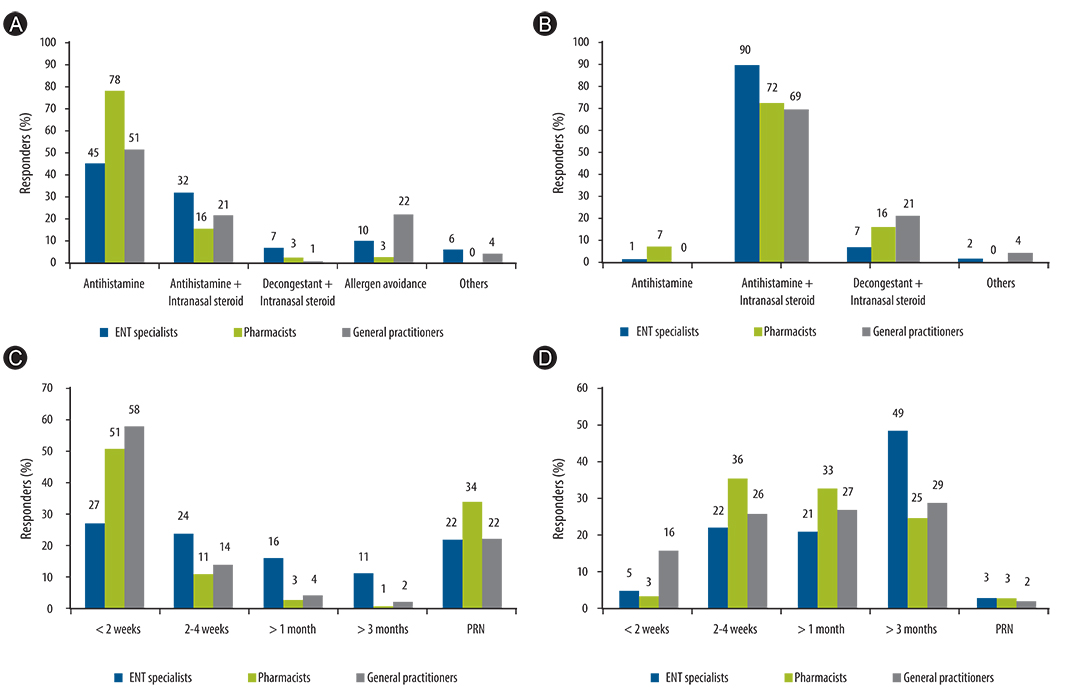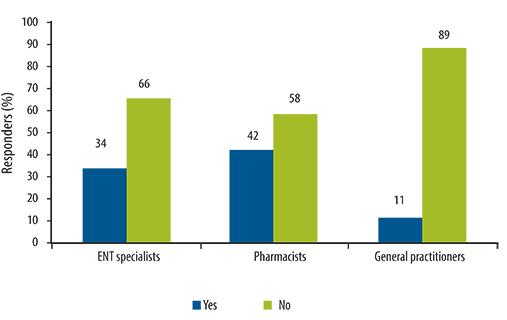Asia Pac Allergy.
2014 Jul;4(3):142-148. 10.5415/apallergy.2014.4.3.142.
The status quo and unmet needs in the management of allergic rhinitis and chronic rhinosinusitis: a Malaysian perspective
- Affiliations
-
- 1Department of Otorhinolaryngology, Head & Neck Surgery, University Malaya Faculty of Medicine, Kuala Lumpur 50603, Malaysia. prepageran@yahoo.com
- 2Department of Otolaryngology, National University of Singapore, Singapore 119077, Singapore.
- 3Lam Wah Ee Hospital, Pulau Pinang 11600, Malaysia.
- 4Department of Dermatology and Allergy, Allergie-Centrum-Charité of the Charité-Universitätsmedizin Berlin, Berlin 10117, Germany.
- KMID: 2397091
- DOI: http://doi.org/10.5415/apallergy.2014.4.3.142
Abstract
- BACKGROUND
Allergic rhinitis and rhinosinusitis, common and debilitating conditions, should be managed in accordance with guideline recommendations. Guideline adherence shows regional differences. As of now, there is little data from Asia and none from Malaysia on the current treatment practices and unmet needs in the management of these conditions.
OBJECTIVE
The objective of this study was to assess the current practice in the management of allergic rhinitis and rhinosinusitis by conducting a survey among ear, nose and throat (ENT) specialists, pharmacists, and general practitioners (GPs) in Malaysia.
METHODS
We conducted a survey study among ENT specialists, pharmacists, and GPs in Malaysia, who answered a multiple choice questionnaire focused on the current practice in the management of allergic rhinitis and rhinosinusitis in their respective field. More than 200 ENT specialists, 100 pharmacists, and 200 GPs participated in the survey.
RESULTS
Antihistamines were the most preferred choice for the treatment of mild allergic rhinitis by ENT specialists (45%), pharmacists (78%), and GPs (51%), with the most preferable duration of <2 weeks. In moderate-to-severe allergic rhinitis, a combination of antihistamines and intranasal steroids was the most preferred treatment of choice in 90% of ENT specialists, 72% of pharmacists, and 69% of GPs. Efficacy of antihistamines was the main criteria of choice in 58%, 53%, and 38% of ENT specialists, pharmacists, and GPs, respectively. Notably, complaints of drowsiness associated with nonsedative antihistamines were the major unmet need identified in the survey. For chronic rhinosinusitis, a combination of antihistamines and intranasal steroids was the most preferred treatment. The majority of the respondents preferred a treatment duration of >3 months with antihistamines. Satisfaction with the recommendations in the current Allergic Rhinitis and its Impact on Asthma (ARIA) guideline was high; 66%, 58%, and 89% of the ENT specialists, pharmacists, GPs, respectively, reported that the current ARIA guidelines are sufficient for their clinical/pharmacy practice.
CONCLUSION
The current practices in the management of allergic rhinitis in Malaysia are largely in line with the ARIA guidelines. The majority of physicians and pharmacists are satisfied with the recommendations in the ARIA guidelines.
Keyword
MeSH Terms
Figure
Cited by 2 articles
-
Allergic rhinitis, chronic rhinosinusitis and nasal polyposis in Asia Pacific: impact on quality of life and sleep
Ashok Shah
Asia Pac Allergy. 2014;4(3):131-133. doi: 10.5415/apallergy.2014.4.3.131.Attitudes, practices on allergic rhinitis of generalists and specialists in Philippine National Capital Region
Cecilia Gretchen Navarro-Locsin, Joel A. Romualdez
Asia Pac Allergy. 2015;5(4):203-209. doi: 10.5415/apallergy.2015.5.4.203.
Reference
-
1. Katelaris CH, Lai CK, Rhee CS, Lee SH, Yun WD, Lim-Varona L, Quang VT, Hwang J, Singh H, Kim J, Boyle JM, Dhong HJ, Narayanan P, Vicente G, Blaiss M, Sacks R. Nasal allergies in the Asian-Pacific population: results from the Allergies in Asia-Pacific Survey. Am J Rhinol Allergy. 2011; 25:Suppl 1. S3–S15.
Article2. Maurer M, Zuberbier T. Undertreatment of rhinitis symptoms in Europe: findings from a cross-sectional questionnaire survey. Allergy. 2007; 62:1057–1063.
Article3. Brozek JL, Bousquet J, Baena-Cagnani CE, Bonini S, Canonica GW, Casale TB, van Wijk RG, Ohta K, Zuberbier T, Schunemann HJ. Global Allergy and Asthma European Network. Grading of Recommendations Assessment, Development and Evaluation Working Group. Allergic Rhinitis and its Impact on Asthma (ARIA) guidelines: 2010 revision. J Allergy Clin Immunol. 2010; 126:466–476.4. Blaiss MS, Katelaris C, Neffen HE. Treatment of nasal allergies: results from the allergies surveys in America, Asia Pacific, Latin America, and Middle East. World Allergy Organ J. 2012; 5:Suppl 2. S146.5. Keith PK, Desrosiers M, Laister T, Schellenberg RR, Waserman S. The burden of allergic rhinitis (AR) in Canada: perspectives of physicians and patients. Allergy Asthma Clin Immunol. 2012; 8:7.
Article6. Canonica GW, Bousquet J, Mullol J, Scadding GK, Virchow JC. A survey of the burden of allergic rhinitis in Europe. Allergy. 2007; 62:Suppl 85. 17–25.
Article7. Minor S. Allergic rhinitis: what's best for your patient? J Fam Pract. 2013; 62:E1–E10.8. Mullol J. Positioning of antihistamines in the Allergic Rhinitis and its Impact on Asthma (ARIA) guidelines. Clin Exp Allergy Rev. 2012; 12:17–26.
Article9. Bielory L, Lien KW, Bigelsen S. Efficacy and tolerability of newer antihistamines in the treatment of allergic conjunctivitis. Drugs. 2005; 65:215–228.
Article10. Meltzer EO, Hamilos DL. Rhinosinusitis diagnosis and management for the clinician: a synopsis of recent consensus guidelines. Mayo Clin Proc. 2011; 86:427–443.
Article



